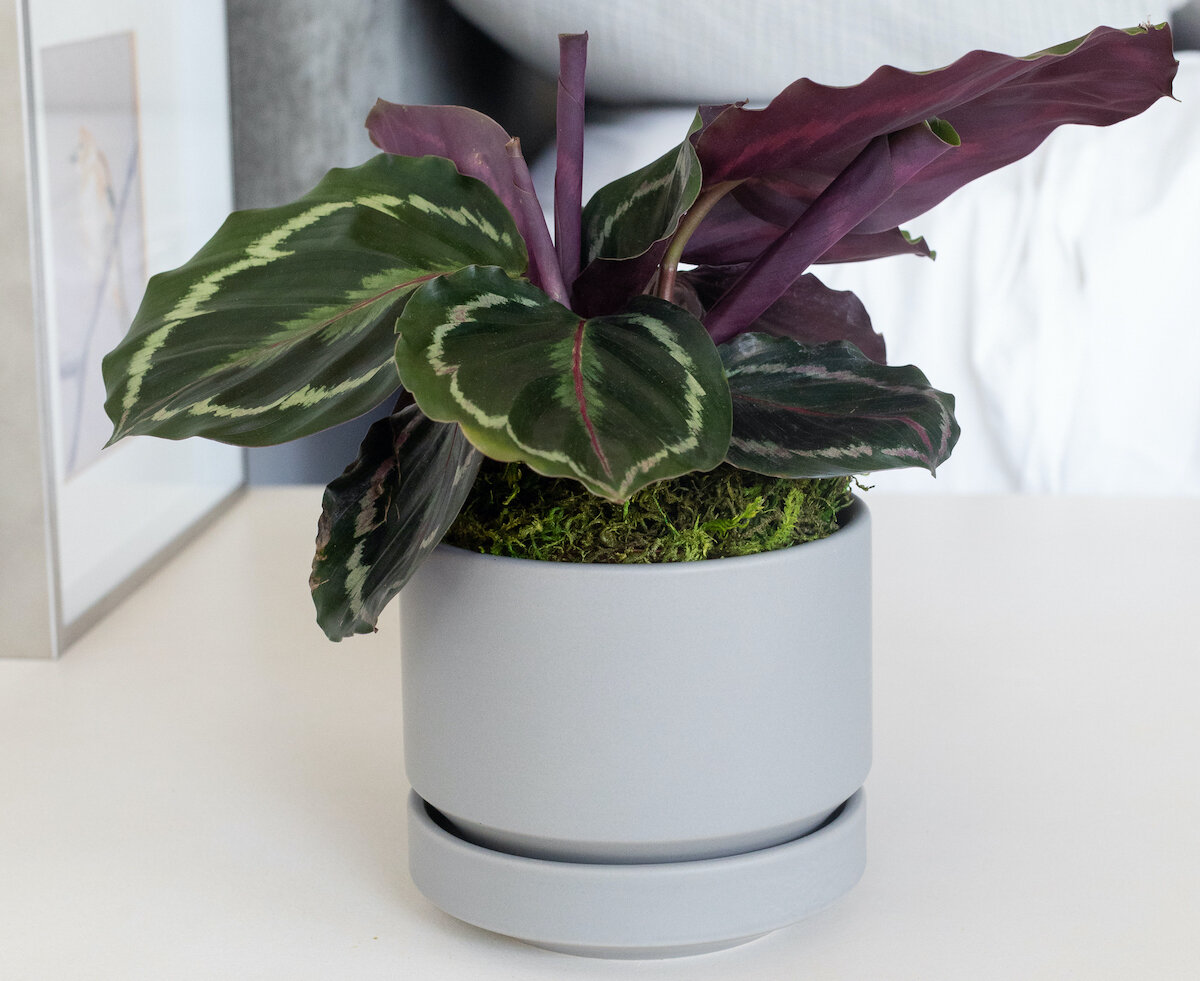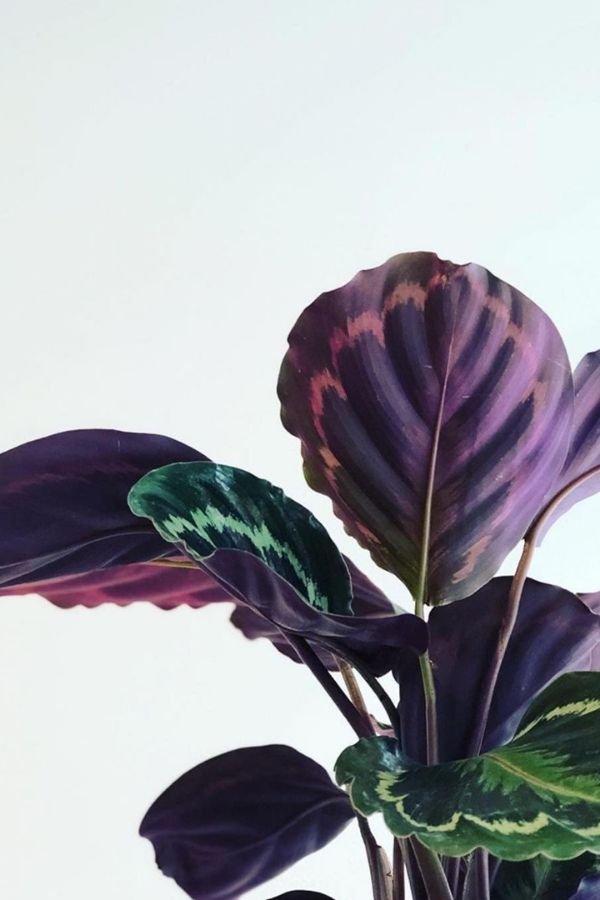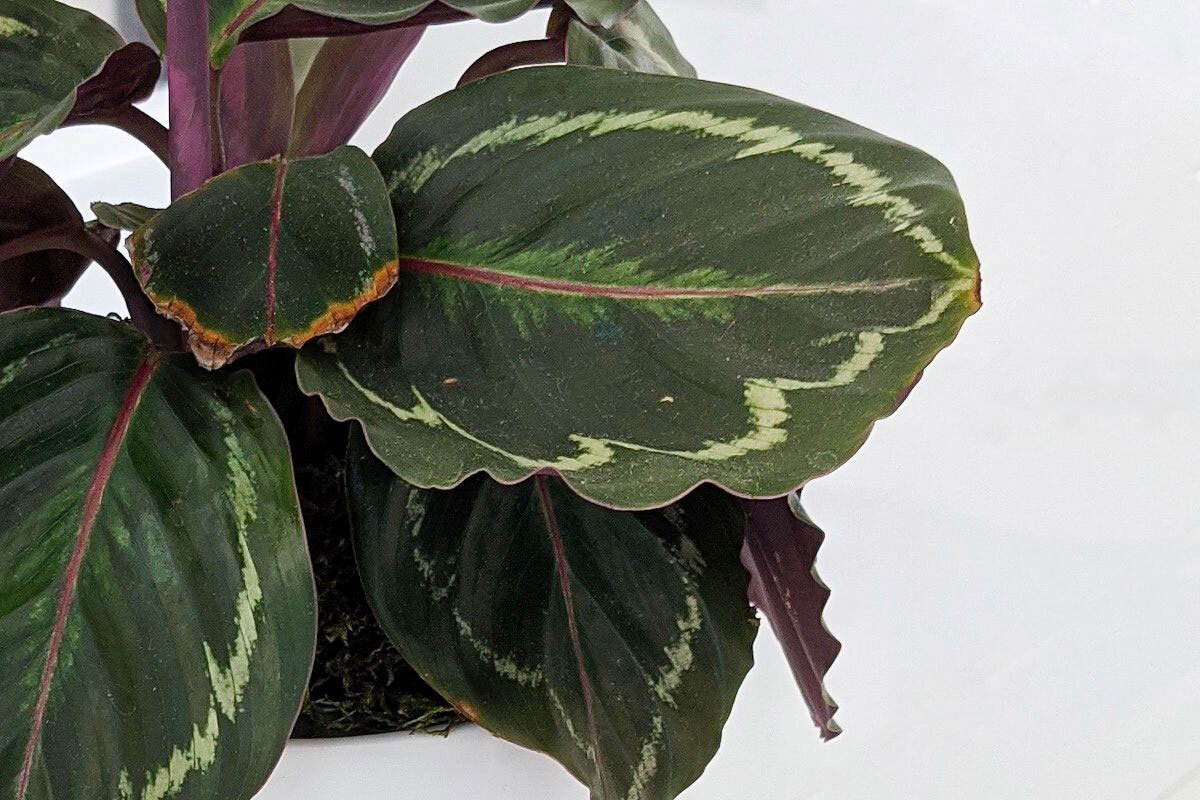The 10 Commandments of Calathea Care
Are you ready to care for your very own Calathea?
With their ethereal beauty and deeply colored foliage, Calatheas are beloved for the spellbinding presence that they bring to any space.
They also have a special quality, known as nyctinasty: their sensitive leaves move in reaction to the light they receive. In the evening, they turn their leaves up, and during daylight hours, they lower them in a beautiful Calathea sun salutation. This behavior is why they’re lovingly referred to as Prayer Plants.
But like any goddess accustomed to being adored, Calatheas appreciate care and consideration. Praise them as you should, and they’ll flourish for years to come. Just follow these 10 commandments!
1. Give Them the Lighting They Love
Your Calathea does not want a sunburn. Ensure that it receives indirect light- medium is best, but low light can be well-tolerated- without exposing your plant to the sun’s direct harsh rays. When in doubt, picture your Calathea in its native habitat: a moist, humid rainforest. The light is filtered by a thick canopy of trees, and the air is heavy with mist. These are the conditions that Calatheas love. So don’t be afraid to keep her in the bathroom!
2. Like all of us, Calatheas Need the Occasional Spa Day
A Native of Brazil, the Calathea appreciates a humid environment which can be difficult to create in indoor spaces. So plan on misting your Calathea regularly (once a week is ideal) to ensure it receives the moisture it craves. Misting is also a great way of interacting with your Calathea and keeping yourself busy without overwatering it, a common mistake that can cause damage that is difficult to undo!
3. Keep Your Calathea Away From Dry Breezes and Appliances
Calatheas are sensitive to even small changes in their environment. Because of this, it’s best to keep them away from vents, air conditioners or heaters, and doors that are frequently opened and closed.
4. A Steady Temperature Is A Must
Seasons change, but your Calatheas should never have to feel a significant temperature shift. Keep these tropical plants comfortable by ensuring a steady temperature within the range of 65-80 degrees year-round, and your Calathea will thank you for it!
Plant Care Essentials
Our full set of apothecary plant essentials was designed to keep your plants clean, insect free and ready to grow. Inspired by the tradition of soaps and perfumes crafted in the south of France, you and your plant alike are sure to enjoy this set of luxurious elixirs
5. Fertilize Your Calathea With Care- and Only During Its Growing Seasons
Calatheas do not need to be fertilized during the winter months, but once Spring arrives, your Calathea will appreciate a monthly dose of foliar plant food like our Foliar Feed, or another gentle fertilizer. This feeding schedule can be continued through the Summer and Fall.
You may feel the urge to feed your Calathea during the slow winter months, but remember that these plants do not grow nearly as much during the cold season and require less food and water during this time. Over-fertilizing has consequences, so be mindful of the particular needs of this delicate and beautiful plant variety.
6. Give Your Calathea A Long Drink of Water
If you notice that your Calathea’s leaves are curling inward and appear dry, your plant may be signaling that it is under-watered. You can give your Calathea a long drink by removing your plant from its ceramic planter, while keeping it in its plastic nursery pot, and placing it in a sink or bowl. Water the Calathea thoroughly and allow it to sit in the collected water for a few hours. Its roots will drink up exactly as much water as they need. After a few hours, remove your Calathea from the sink or bowl and allow it to drain. Your Calathea should show signs of improving health within a day.
7. Prune Unhealthy Leaves
It’s normal to feel trepidation about pruning (cutting leaves or stems off of your plant.) However, it’s actually great to get in the practice of pruning your plants because pruning offers so many benefits to the plant’s overall health. All plants will grow over time if they receive the light and water that they need, and all plants will experience occasional dying leaves. It’s just part of life!
Don’t be afraid to prune off leaves of your Calathea that appear dead or mostly dead. You can simply cut them with scissors or pruning shears at the spot where they meet the stem or base of the plant. If your Calathea’s leaf has only one area of browning, you can trim the brown area off by following the natural curve of the leaf with scissors. If you need a little more guidance, head here for a full step-by-step guide to pruning houseplants.
8. As With All Living Things, Patience is Key!
Calatheas are known for being fussy plants. Like many indoor plants, they’re native to very moist and tropical locations that are a world away from most of our home environments. Your Calathea may experience leaf drop, browning or other growing pains- especially as it becomes accustomed to a new home.
The flip side, of course, (and it’s so worth it!) is that it will also generate new growth and adorn your home with beauty in the months and years to come. So be patient as your Calathea settles in, and take time to give her special care. She may be a diva, but it’s all part of what makes her a beautiful and unique plant.
9. Don’t Be Afraid to Repot
As with pruning, repotting can feel like a daunting responsibility, and one that you might rather avoid. That being said, there are tremendous benefits to repotting your Calathea every year or two.
Over time, soil loses its nutrients- they’re used up by the plants to keep them growing healthy and strong. Repotting is a great opportunity to replace some of that old soil with new, nutrient-rich soil for your Calathea to enjoy. Repotting your Calathea in a larger pot also ensures that your plant has the space to spread out and push out new growth! First time repotting? See our full guide to learn how to repot your plant.
10. Introduce the Company of Friends
Did you know that plants love to be grouped together? By arranging your houseplants close to one another, they create a mini-biome of moisture that can benefit them all. Grouping your plants together also makes it easier to remember to water, feed and pamper them! Just remember to be sure that the plants you’re grouping together will thrive in the conditions of the space, and that their light and water requirements align.
Consider the rule of three: groupings of three plants in one space are aesthetically harmonious and easy to tend to- especially if you keep your mister and watering can right by them. (The House of Botanicals Watering Can, for instance, contains a mister and watering spout in one, and it’s so pretty that it functions as decor!)
Every new plant is a new adventure, and Calatheas are no exception.
They’re gorgeous, spiritual and have a vibrant history of varied uses. So embrace your Calathea, and don’t forget that there’s a wealth of information available to support you on your journey right here.
1 TO 1 VIDEO CALL WITH AN EXPERT
Yellow leaves? Worried about watering or struggling with incorrect lighting? Book a call and get truly personalized support for all your plant-related needs.









